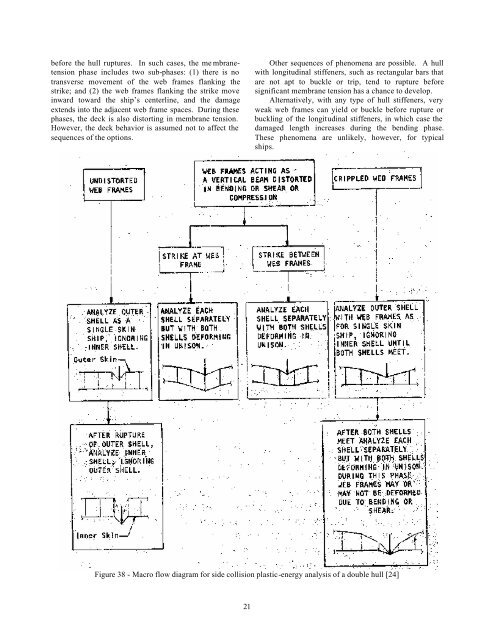Structural Design and Response in Collision and Grounding
Structural Design and Response in Collision and Grounding
Structural Design and Response in Collision and Grounding
Create successful ePaper yourself
Turn your PDF publications into a flip-book with our unique Google optimized e-Paper software.
efore the hull ruptures. In such cases, the me mbranetensionphase <strong>in</strong>cludes two sub-phases: (1) there is notransverse movement of the web frames flank<strong>in</strong>g thestrike; <strong>and</strong> (2) the web frames flank<strong>in</strong>g the strike move<strong>in</strong>ward toward the ship’s centerl<strong>in</strong>e, <strong>and</strong> the damageextends <strong>in</strong>to the adjacent web frame spaces. Dur<strong>in</strong>g thesephases, the deck is also distort<strong>in</strong>g <strong>in</strong> membrane tension.However, the deck behavior is assumed not to affect thesequences of the options.Other sequences of phenomena are possible. A hullwith longitud<strong>in</strong>al stiffeners, such as rectangular bars thatare not apt to buckle or trip, tend to rupture beforesignificant membrane tension has a chance to develop.Alternatively, with any type of hull stiffeners, veryweak web frames can yield or buckle before rupture orbuckl<strong>in</strong>g of the longitud<strong>in</strong>al stiffeners, <strong>in</strong> which case thedamaged length <strong>in</strong>creases dur<strong>in</strong>g the bend<strong>in</strong>g phase.These phenomena are unlikely, however, for typicalships.Figure 38 - Macro flow diagram for side collision plastic-energy analysis of a double hull [24]21
















